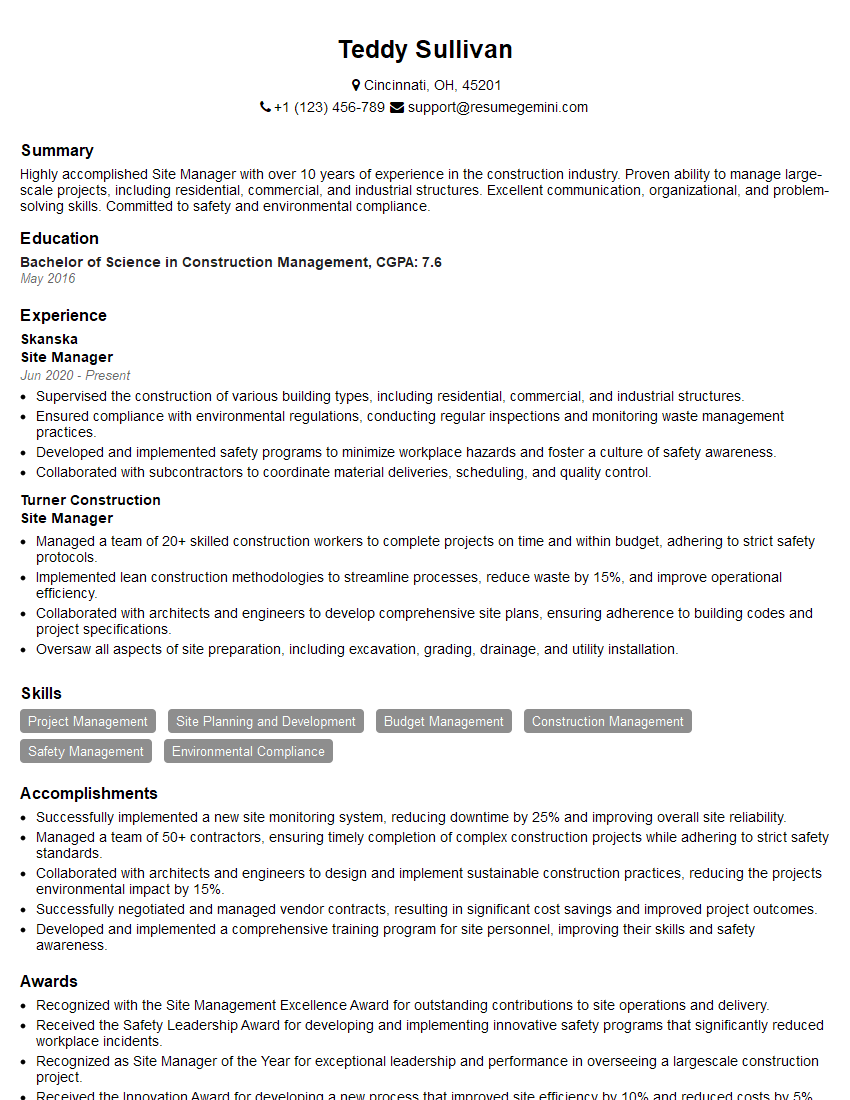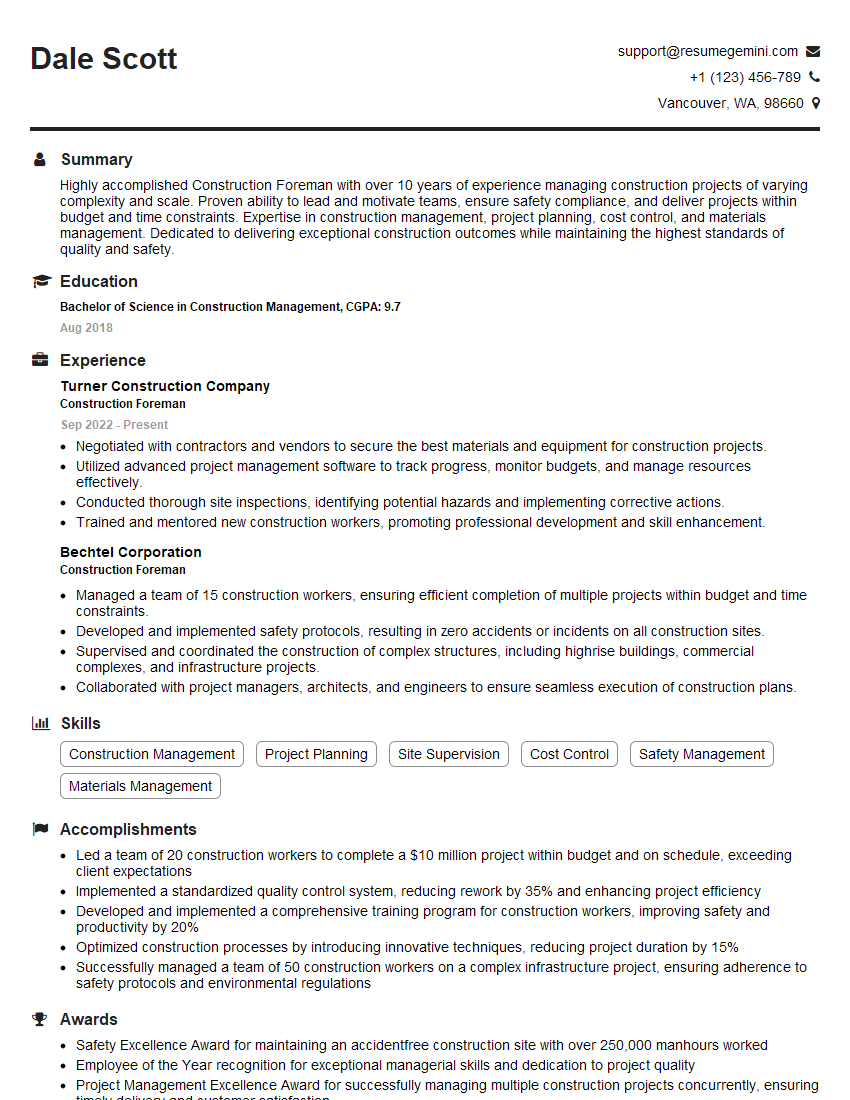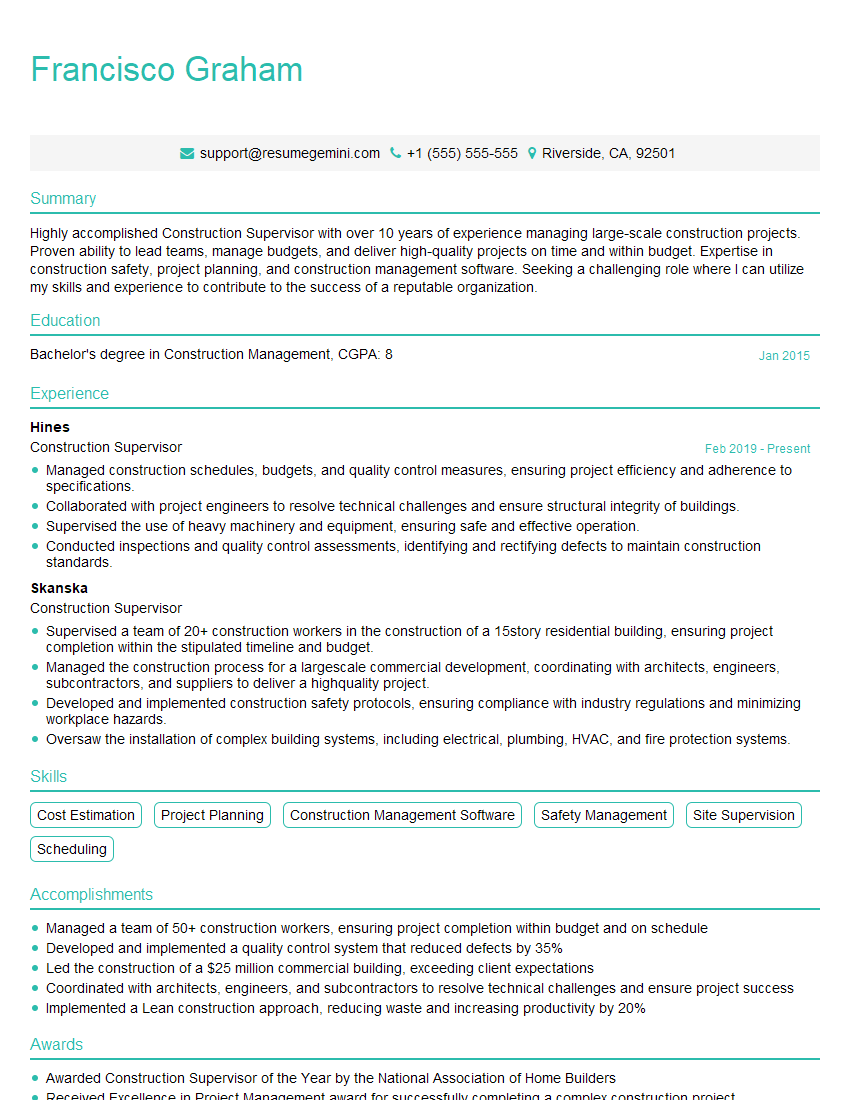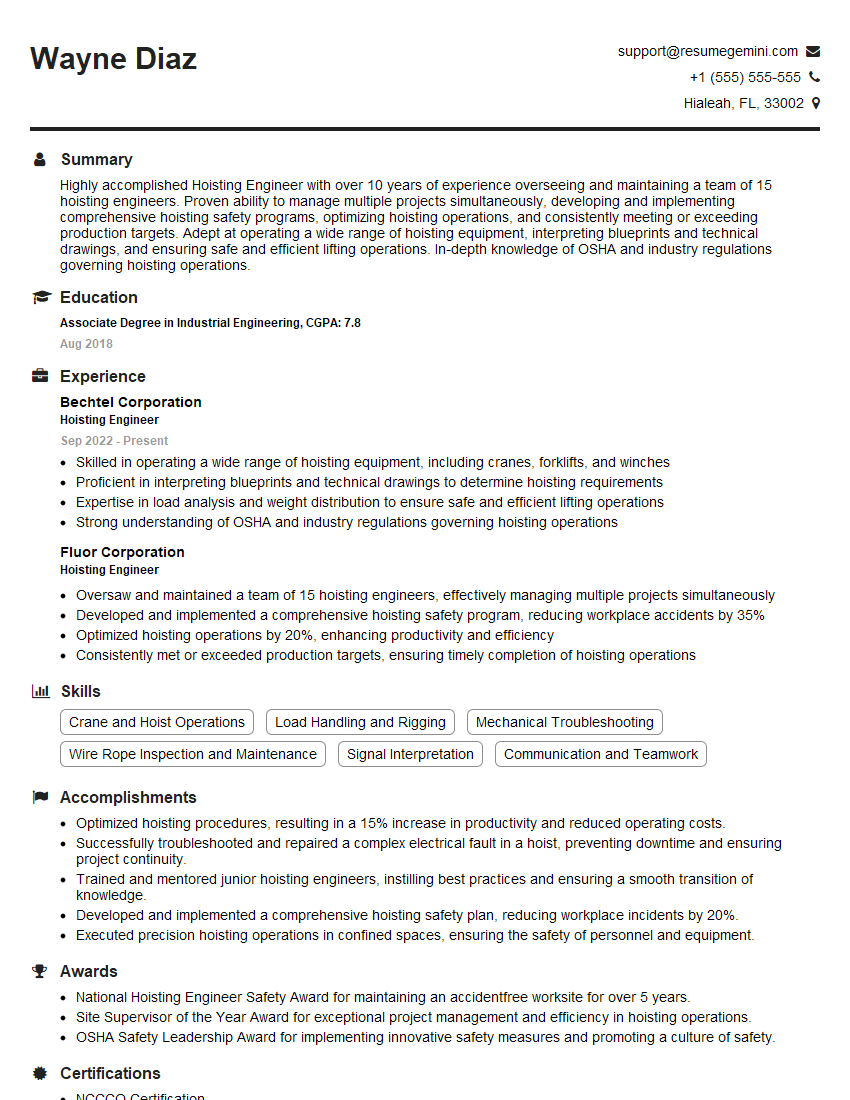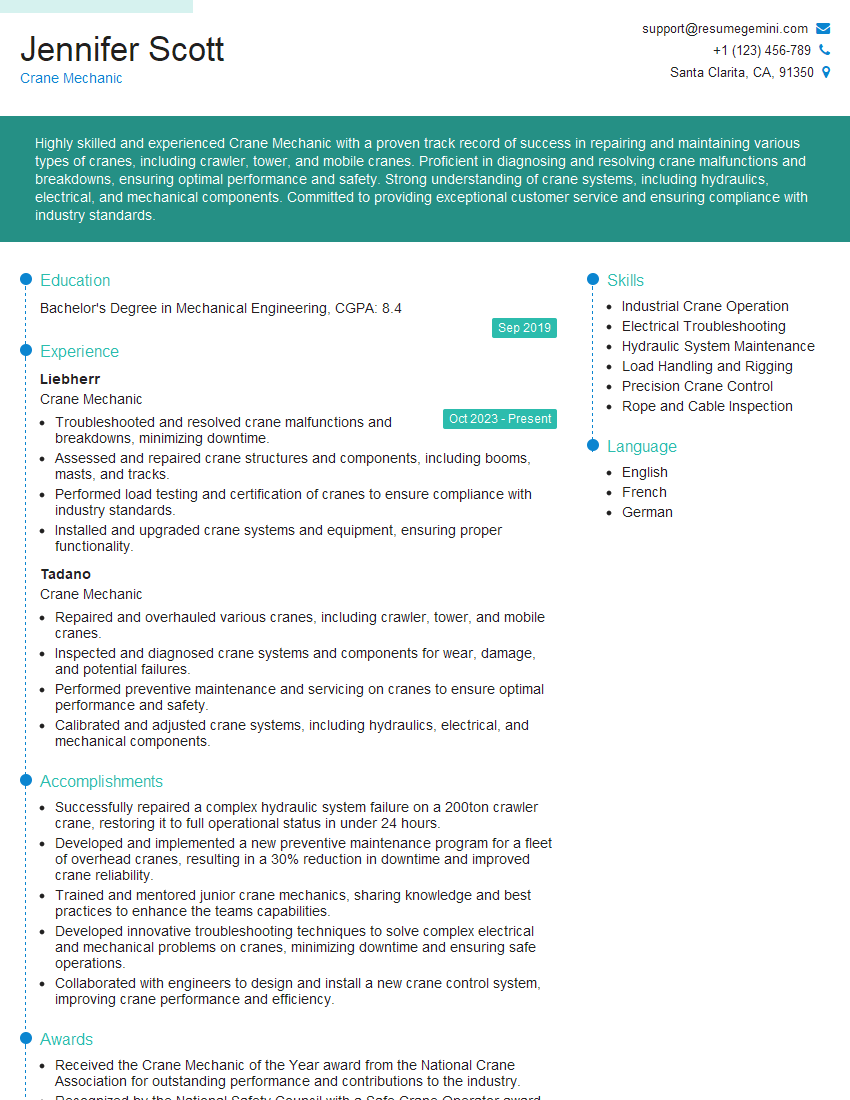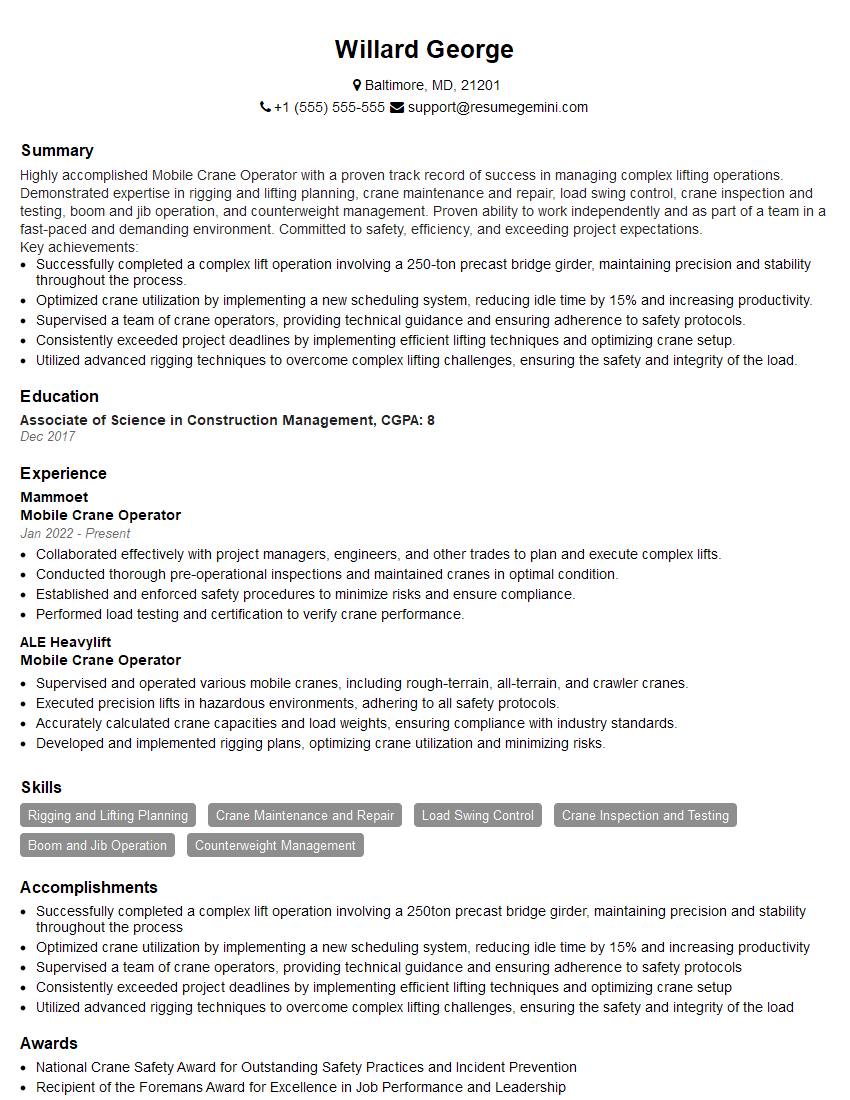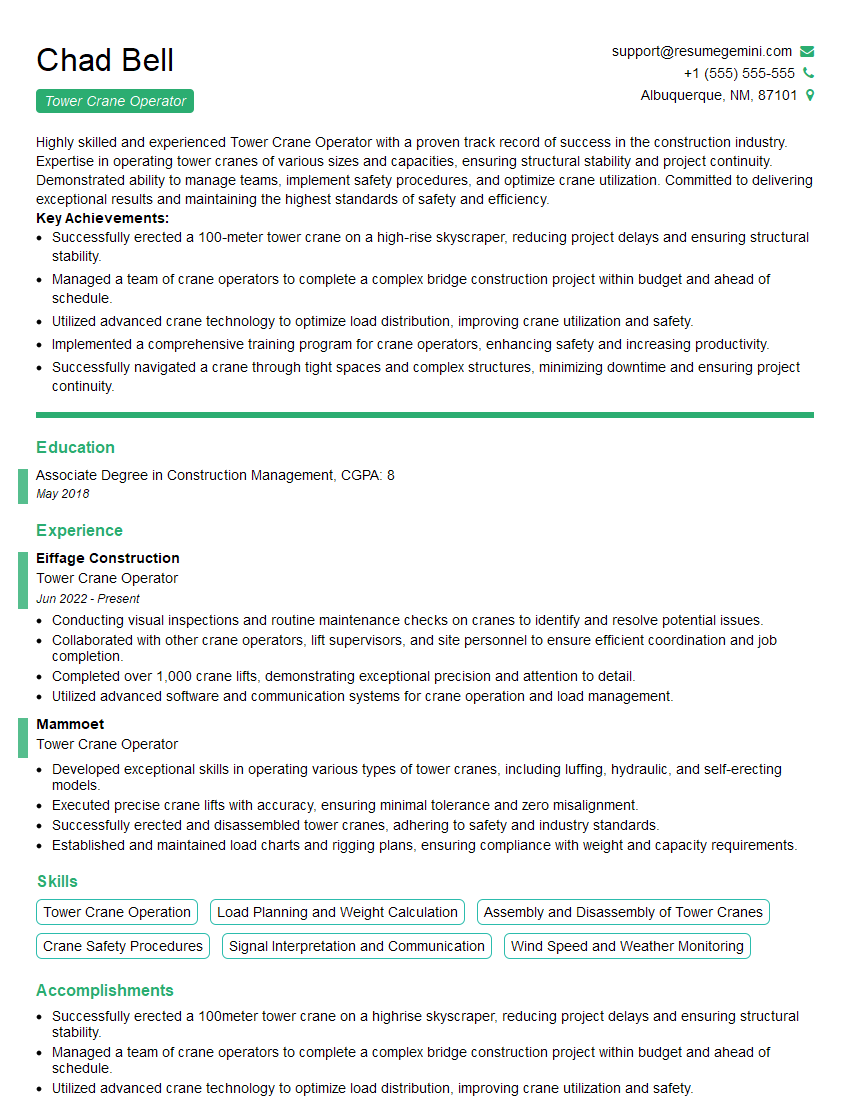Interviews are more than just a Q&A session—they’re a chance to prove your worth. This blog dives into essential Position the boom accurately interview questions and expert tips to help you align your answers with what hiring managers are looking for. Start preparing to shine!
Questions Asked in Position the boom accurately Interview
Q 1. Explain the concept of boom swing radius and its impact on accurate positioning.
The boom swing radius is the maximum horizontal distance a crane’s boom can reach from its pivot point. Think of it like the length of a clock’s hand – the further the hand extends, the wider the swing. Accurate positioning is crucial for safety and efficiency. A miscalculated swing radius can lead to collisions with nearby objects or structures, potentially causing damage or injury. The shorter the swing radius, the more precise the positioning control becomes. Conversely, longer swing radii necessitate more cautious operation and precise calculations to account for potential swing paths.
For instance, during the construction of a high-rise building, a crane’s boom might need to maneuver within a tight space. In such cases, understanding the swing radius is critical to avoid hitting adjacent buildings or other equipment. A precise understanding of the boom’s maximum reach at different boom angles is crucial in determining the feasibility of a lift and avoiding dangerous situations.
Q 2. Describe the different types of boom configurations and their suitability for various tasks.
Crane booms come in various configurations, each suited for different tasks. Common types include:
- Lattice Boom: These are built from interconnected triangular sections, offering high strength-to-weight ratios. They are ideal for heavy lifting applications where a long reach is required, like large construction projects.
- Telescopic Boom: These booms extend hydraulically, allowing for variable reach and flexibility. Their compact design makes them suitable for confined spaces. They’re commonly found in mobile cranes and are versatile enough for many different lifting scenarios.
- Articulated Boom: These feature multiple hinged segments, providing exceptional maneuverability and reach in various directions. They are perfect for precise placement in tight or awkward spaces, frequently used in specialized applications like industrial maintenance or filming.
- Knuckle Boom: Similar to articulated booms, but with a more rugged design often found on truck-mounted cranes and heavy-duty lifting applications.
The choice of boom configuration depends heavily on the specific job requirements. For example, a lattice boom might be necessary for lifting extremely heavy components on a large bridge, whereas a telescopic boom would be more suitable for a construction project requiring precise placement of materials in a crowded urban environment.
Q 3. How do you account for wind speed and direction when positioning a boom?
Wind significantly impacts boom positioning. Strong winds can cause the boom to sway and affect the accuracy of placement, potentially leading to accidents. Before initiating any lift, wind speed and direction must be assessed. This is usually done using anemometers that measure wind speed and direction. Wind speed limits are often specified in the crane’s operation manual. If wind speeds are too high, the lift should be postponed.
Strategies to mitigate wind effects include:
- Reducing Boom Length: Shortening the boom reduces its surface area exposed to the wind, lessening its sway.
- Adjusting Boom Angle: Tilting the boom to minimize its profile against the wind can help.
- Using Outriggers: Deploying outriggers increases stability and minimizes the effect of wind forces.
- Careful Operator Technique: Experienced operators can use smooth, controlled movements to counteract wind effects.
For example, I remember a situation where high winds were predicted during a bridge construction project. To ensure safety, we shortened the boom length and employed extra outriggers, significantly reducing the risk of accidents.
Q 4. What safety measures are critical when precisely positioning a boom?
Safety is paramount when positioning a boom. Critical measures include:
- Regular Inspections: Thorough pre-operation inspections of all boom components, including cables, hydraulics, and structural integrity, are mandatory.
- Load Charts: Always refer to load charts to ensure the lift is within the crane’s safe working limits.
- Proper Training: Operators must be fully trained and certified on the specific crane model they are operating.
- Safe Working Radius: Maintain a safe distance from obstacles and personnel within the swing radius.
- Emergency Shutdown Systems: Familiarize yourself with and test emergency stop mechanisms.
- Load Monitoring: Continuously monitor the load throughout the lifting process.
- Communication: Clear communication between the crane operator, rigger, and ground personnel is essential.
- Personal Protective Equipment (PPE): Always wear appropriate PPE such as helmets, safety harnesses, and safety glasses.
Failure to adhere to these safety measures can result in serious accidents, emphasizing the need for strict adherence to established protocols and training.
Q 5. Explain the process of calculating the lifting capacity of a boom at different angles.
Calculating the lifting capacity at different angles requires using load charts provided by the crane manufacturer. These charts typically show the maximum safe load for various boom lengths and angles. The capacity reduces as the boom angle increases or the boom is extended further. This is due to the increased moment arm, creating more stress on the crane structure.
The calculation often involves complex engineering principles that consider the crane’s design, material properties, and safety factors. These calculations are usually pre-computed and presented in the load charts to simplify the process for the operator. There’s no simple formula as the calculations are based on the specific crane model and are beyond the scope of simple arithmetic. You must always consult the load charts provided with your specific crane.
For example, if the load chart shows a maximum capacity of 10 tons at a 30-degree boom angle and a certain boom length, the capacity will likely be lower at a 45-degree angle with the same boom length.
Q 6. How do you use load charts and swing radius indicators to ensure safe boom positioning?
Load charts are essential for safe boom positioning; they provide the maximum allowable loads at different boom angles and radii. Swing radius indicators provide a visual representation of the crane’s reach, often displayed on a dial or digital display. They are crucial in preventing collisions. Before lifting, always locate the correct section on the load chart based on the boom length and angle. Then, check if the load to be lifted falls within the safe working load limit (SWL) indicated on the chart. Simultaneously, use the swing radius indicator to ensure the boom’s movement will not endanger any people or structures.
Imagine this scenario: you’re lifting a heavy piece of equipment. You consult the load chart and see that the weight you are lifting is within the SWL for the boom length and angle. You also visually check the swing radius indicator to confirm that the swing will not interfere with any nearby structures. Only once both are confirmed do you commence the lift.
Q 7. Describe your experience with different types of boom control systems (e.g., manual, computerized).
My experience encompasses both manual and computerized boom control systems. Manual systems, while requiring more skill and precision from the operator, provide a degree of direct control and feel that computerized systems may sometimes lack. However, computerized systems offer advantages like increased accuracy, automated safety features (e.g., load moment indicators, anti-collision systems), and data logging capabilities.
I’ve worked extensively with systems incorporating PLC (Programmable Logic Controller) based controls providing feedback on load, position, and speed; and these advanced systems help prevent overloading or exceeding safe operating limits. With manual systems, I found that experience and a strong understanding of physics, coupled with visual feedback, were key to accurate positioning. However, there’s definitely a greater risk of error or fatigue with manual operation. In contrast, computerized systems, while highly efficient and precise, need regular calibration and maintenance to ensure the accuracy of the control systems.
Q 8. How do you handle unexpected obstacles or changes in terrain during boom positioning?
Handling unexpected obstacles during boom positioning requires a combination of pre-planning, situational awareness, and quick problem-solving. Before any lift, we thoroughly assess the terrain using site surveys and maps, identifying potential hazards like uneven ground, underground utilities, or obstructions. During the lift, if unforeseen obstacles appear, I immediately halt the operation and reassess the situation. This might involve using alternative boom configurations, adjusting the lifting plan, or even requesting additional equipment or personnel.
For example, if I encounter unexpectedly soft ground, I wouldn’t try to force the positioning. I’d consider using ground mats or cribbing to distribute the weight and ensure stability. If an unexpected obstruction like a low-hanging branch appears, I’d communicate this immediately to the ground crew, and we’d collaboratively adjust the boom path to avoid collision, potentially needing to re-plan the lift completely. Safety always comes first, and pausing the operation is far preferable to risking damage or injury.
Q 9. What are the potential consequences of inaccurate boom placement?
Inaccurate boom placement can have severe consequences, ranging from minor damage to catastrophic failure. Minor inaccuracies could lead to load instability, resulting in swaying, potential damage to the load or surrounding structures, and delays in the operation. More significant inaccuracies could result in the load tipping or dropping, causing substantial property damage, injury to personnel, or even fatalities. The consequences depend on the weight and nature of the load, the height of the lift, and the severity of the misplacement.
For instance, a slightly off-center placement of a heavy HVAC unit could cause it to stress the building’s structural supports. A major miscalculation while lifting a large piece of equipment in a confined space could lead to serious damage or injury.
Q 10. How do you ensure proper communication and coordination with ground personnel during boom operation?
Clear and consistent communication is crucial for safe and efficient boom operations. I utilize a combination of hand signals, two-way radios, and pre-established communication protocols to coordinate with ground personnel. Before commencing any lift, we review the lift plan, ensuring everyone understands their roles and responsibilities. During the operation, I provide continuous updates on the boom’s position and any changes in the plan. Ground personnel are responsible for guiding me using clear and concise instructions, and I acknowledge all directions before executing them. This collaborative approach eliminates misunderstandings and ensures a smooth operation.
For example, using standardized hand signals prevents misinterpretations when radio communication might be difficult. A simple ‘thumbs up’ for confirmation of understood instructions significantly reduces risk.
Q 11. Explain your understanding of load stability and how it relates to boom positioning.
Load stability is paramount in boom positioning. It refers to the ability of the load to remain balanced and secure throughout the lifting and positioning process. This is directly impacted by the boom’s position and angle, the weight distribution of the load, and the overall stability of the crane and its foundation. An improperly positioned boom can create uneven weight distribution, leading to instability. This is often exacerbated by wind, the load’s center of gravity, and the type of rigging used.
Imagine lifting a long, thin beam. Placing the boom at the wrong angle could cause the beam to swing during the lift, risking damage and instability. Careful boom positioning, considering the load’s center of gravity and distributing the weight evenly, is crucial to maintain stability and prevent accidents.
Q 12. What are the common causes of boom malfunctions and how do you address them?
Boom malfunctions can stem from various causes, including hydraulic system issues, electrical faults, mechanical failures, and operator error. Hydraulic leaks can reduce lifting power and stability, while electrical problems might impact the boom’s control systems. Mechanical issues can include worn bearings, damaged gears, or structural fatigue in the boom itself. Operator error, such as incorrect operation of controls or overloading the boom, can also lead to malfunctions.
Addressing these malfunctions requires a systematic approach. I always start with a thorough inspection, identifying the specific problem. For hydraulic leaks, the system needs to be inspected for leaks and damage, and components might need replacement. Electrical faults require careful tracing to isolate the problem. Mechanical issues may necessitate repairs or component replacement. In case of operator error, retraining might be needed to prevent future occurrences.
Q 13. Describe your experience with pre-lift planning and its role in accurate boom positioning.
Pre-lift planning is the cornerstone of accurate boom positioning. It involves a detailed assessment of the lift parameters, including the weight, dimensions, and center of gravity of the load, the terrain conditions, the location of obstructions, and the availability of access routes. This plan outlines the optimal boom configuration, angle, and lifting technique to ensure safe and efficient placement. The planning phase also includes risk assessments and contingency plans to address potential problems.
For example, I once had to lift a heavy transformer into a tight urban space. Pre-lift planning revealed that we needed to utilize a specific boom configuration to avoid power lines and nearby buildings. We also established a clear communication plan and designated spotters to monitor the lift’s progress. The thorough plan prevented any incidents and ensured successful execution.
Q 14. How do you perform a pre-operational inspection of a boom and its related components?
A pre-operational inspection is crucial before any boom operation. It involves a thorough visual examination of all components, including the boom itself, the hydraulic system, the electrical system, the control systems, and the rigging equipment. I check for any visible damage, leaks, loose connections, or signs of wear and tear. I verify that all safety devices, such as limit switches and emergency stops, are functioning correctly. The inspection also includes checking the crane’s load chart to ensure the crane is adequately rated for the load being lifted.
I use a checklist to systematically inspect each component, noting any deficiencies found. If any issues are discovered, I address them before commencing the operation. This proactive approach minimizes the risk of malfunctions and ensures the safe operation of the boom.
Q 15. What are the limitations of the boom and how do you work within these constraints?
Crane booms, while incredibly versatile, have inherent limitations. Their reach is finite, dictated by their length and the crane’s lifting capacity. They also have a maximum load capacity that decreases as the boom extends further. Furthermore, boom stability is affected by factors like wind speed and ground conditions.
To work within these constraints, I meticulously consult load charts (discussed further in Question 6) before every lift. This helps me determine the maximum allowable load for a given boom extension and angle. I always factor in wind speeds and ground stability assessments. For example, if working on uneven ground, I’ll utilize outriggers to increase the crane’s stability base, further extending the working area. If the job requires a lift beyond the boom’s reach, I’ll propose alternative solutions, such as using a larger crane or employing different lifting techniques.
Career Expert Tips:
- Ace those interviews! Prepare effectively by reviewing the Top 50 Most Common Interview Questions on ResumeGemini.
- Navigate your job search with confidence! Explore a wide range of Career Tips on ResumeGemini. Learn about common challenges and recommendations to overcome them.
- Craft the perfect resume! Master the Art of Resume Writing with ResumeGemini’s guide. Showcase your unique qualifications and achievements effectively.
- Don’t miss out on holiday savings! Build your dream resume with ResumeGemini’s ATS optimized templates.
Q 16. How do you compensate for the effects of ground conditions on boom stability?
Ground conditions significantly impact boom stability. Soft soil, for instance, can cause the crane to sink or tilt, compromising the lift’s safety. To compensate, I conduct a thorough site survey before any operation. This includes assessing the ground’s bearing capacity, looking for any signs of instability, and determining the appropriate placement of outriggers or mats.
If the ground is unsuitable, I might suggest using ground improvement techniques like compaction or the placement of reinforced pads under the outriggers. For example, during a recent project on a reclaimed landfill, we used large steel mats to distribute the crane’s weight, preventing it from sinking into the unstable ground. Accurate ground analysis and proactive mitigation strategies are crucial for safe boom operation.
Q 17. Explain your knowledge of different types of crane booms (e.g., lattice, telescopic).
Crane booms come in various designs, each with its strengths and weaknesses.
- Lattice booms are constructed from interconnected trusses, offering high strength-to-weight ratios and allowing for significant reach. They are frequently used in heavy-lifting applications. However, they are more complex to assemble and disassemble.
- Telescopic booms consist of multiple sections that extend and retract hydraulically. They are advantageous for their versatility and ease of adjustment, making them ideal for jobs requiring different reaches within a single setup. However, they generally have a lower lifting capacity at full extension than lattice booms of comparable length.
Other types include jib booms (used to extend the reach of the main boom), and knuckle booms (which feature articulated sections for greater flexibility and maneuverability in confined spaces). Selecting the right boom type depends heavily on the project’s specific requirements, including lifting capacity, reach, and the complexity of the jobsite.
Q 18. How do you manage the risk of boom overturning or collapsing?
Boom overturning or collapse is a serious risk. My approach to managing this involves a multi-layered strategy.
- Rigorous Pre-Lift Planning: This includes careful review of the load chart, site assessment, and weather conditions.
- Proper Crane Setup: Correctly positioning the outriggers, ensuring level ground, and utilizing all available stabilizing mechanisms are crucial.
- Load Monitoring: Continuously monitoring the load during lifting to ensure it remains within safe parameters.
- Experienced Crew: A skilled and experienced team is essential to execute the lift safely and efficiently.
- Emergency Procedures: Having clear emergency procedures in place, including communication protocols and shutdown mechanisms, is crucial for responding to unexpected events.
For example, if strong winds are anticipated, I’ll either postpone the lift or implement additional safety measures like using stronger guy wires to stabilize the boom.
Q 19. How do you use technology (e.g., GPS, laser levels) to assist in accurate boom placement?
Technology plays a vital role in accurate boom placement.
- GPS systems can aid in precise positioning of the crane, ensuring it’s located optimally for the lift.
- Laser levels provide accurate vertical and horizontal references, ensuring the boom is at the correct angle for the intended placement.
- 3D modeling software enables pre-planning of the lift, visualizing the crane’s movement and boom positioning to identify potential conflicts or obstructions before commencing the operation.
In a recent project, we used a combination of GPS and laser leveling to place prefabricated modular units onto a building’s roof with millimeter accuracy, minimizing the risk of damage and ensuring a smooth, efficient construction process.
Q 20. Explain your understanding of load charts and their importance in safe operation.
Load charts are essential documents that provide the maximum lifting capacity for a given crane boom configuration – boom length, boom angle, and radius. They are critical for safe operation. These charts are specific to each crane model and must be strictly followed.
Before each lift, I carefully consult the load chart to determine the allowable load for the specific boom configuration. This ensures that the crane is not overloaded, preventing potentially catastrophic failures. The chart also outlines the crane’s lifting capabilities under various conditions, such as different wind speeds, ground conditions, and boom angles. Ignoring the load chart is a serious safety violation and will not be tolerated. Understanding and correctly interpreting the load chart is fundamental to safe boom operation.
Q 21. Describe your approach to problem-solving in scenarios involving boom positioning challenges.
My approach to problem-solving during boom positioning challenges follows a structured process:
- Identify the problem: Accurately determine the specific issue causing the positioning challenge, whether it’s an obstruction, unsuitable ground conditions, or an inaccurate load calculation.
- Gather information: Collect relevant data, such as crane specifications, load details, site conditions, and weather information.
- Develop solutions: Brainstorm potential solutions, considering safety as the top priority. This might involve adjusting the boom angle, relocating the crane, using additional support equipment, or even employing alternative lifting techniques.
- Evaluate solutions: Assess each potential solution based on safety, feasibility, and efficiency. This often involves consulting with the engineering team or safety officer.
- Implement the chosen solution: Carefully implement the selected solution, ensuring that all safety measures are in place.
- Monitor and evaluate the results: Observe the outcome and make necessary adjustments to optimize the process for future lifts. Document the entire process for future reference.
This systematic approach ensures that any challenges are addressed safely and efficiently, maintaining the highest standards of safety and project success.
Q 22. How do you ensure the boom is properly secured and locked in position?
Securing a boom involves a multi-step process that prioritizes safety. First, you’ll ensure all locking mechanisms, typically pins or hydraulic locking systems, are fully engaged. A visual inspection is crucial; you must confirm that these mechanisms are properly aligned and showing no signs of damage or wear. Next, I always perform a ‘test tug’ – a gentle, controlled attempt to move the boom – to verify the locking mechanism’s integrity. Any movement beyond a minimal amount of play indicates a problem requiring immediate attention. Finally, depending on the specific crane and the type of operation, additional safety measures might be implemented, such as secondary securing devices or outriggers properly deployed and locked in place. Think of it like locking your car: you wouldn’t just rely on the door lock alone; you’d likely engage multiple security measures, and securing a boom is no different.
Q 23. What is your process for verifying the accuracy of boom placement before commencing lifting operations?
Verifying boom placement is paramount before lifting. I utilize a combination of methods. Firstly, a pre-lift assessment involving a thorough review of the load chart, considering the load’s weight, dimensions, and center of gravity, is essential. This ensures the boom’s configuration aligns with the crane’s capacity and stability limits. Secondly, I use a combination of visual checks, measuring tapes, and laser pointers to verify the boom’s position relative to the load and the surrounding environment. For example, I would measure the distance from the boom’s tip to the lifting point on the load, making sure that it’s within acceptable tolerances. Any deviation is immediately addressed to ensure safety and accuracy. Finally, if available, I’ll leverage advanced technology such as load moment indicators (LMIs) that provide real-time feedback on the crane’s stability and load capacity, further enhancing the accuracy verification process.
Q 24. How do you account for the weight and center of gravity of the load when positioning the boom?
Accounting for weight and center of gravity is fundamental to safe boom positioning. The load’s weight directly influences the crane’s stability and the required boom length and angle. Improper weight estimations can lead to tipping or structural failure. Similarly, the center of gravity dictates the optimal boom position. An off-center load creates an uneven distribution of weight, requiring adjustments to maintain balance. I use load charts provided by the crane manufacturer to calculate the correct boom configuration. These charts consider various factors to determine safe operating limits. For instance, I might need to extend the boom further and/or adjust the boom angle to compensate for a high center of gravity. Using load charts ensures I stay well within the rated capacity of the crane, preventing dangerous situations.
Q 25. Describe a time when you had to adjust your boom positioning due to unforeseen circumstances.
During a high-rise construction project, we were lifting a prefabricated section of a building. The wind unexpectedly picked up to speeds exceeding the safe operating limits, and it started to affect the stability of the load. Our pre-calculated boom position was no longer safe. Immediately, I communicated the change in conditions to the ground crew and crane supervisor. We carefully and slowly lowered the load, reevaluated the wind conditions, and adjusted the boom position, extending it further to account for the wind’s impact on the load. We also used additional rigging techniques to secure the load and to minimize the impact of the increased wind speeds before resuming the lift. This situation highlighted the importance of constant situational awareness and the ability to quickly adapt to changing circumstances while prioritizing safety.
Q 26. What are the legal and regulatory requirements related to safe boom operation in your region?
Legal and regulatory requirements for safe boom operation are stringent in my region. Operators must possess valid certifications and licenses demonstrating competency and adherence to safety standards. These requirements include regular safety inspections, rigorous training programs that cover emergency procedures and safe operating practices, and adherence to load capacity limits. Furthermore, detailed pre-lift inspections are mandatory, and comprehensive documentation must be maintained for each operation. We are also subject to regular audits by regulatory bodies to ensure compliance. Non-compliance can result in significant penalties, including fines and suspension of operating licenses. These regulations are crucial for protecting both the operator and the public from potential accidents.
Q 27. Explain the importance of ongoing training and continuing education for boom operators.
Ongoing training is paramount for boom operators. The industry is constantly evolving, with new technologies, safety protocols, and equipment emerging regularly. Continuing education keeps operators updated on the latest best practices and safety procedures. This includes refreshers on safe operating limits, emergency response protocols, and new technological advancements in crane control and load monitoring. Staying current on regulations also ensures legal compliance. Furthermore, advanced training helps operators develop problem-solving skills and enhance their ability to handle unforeseen circumstances safely and efficiently. For example, advanced training might include simulations of difficult lifting scenarios, preparing them to handle high-risk situations effectively and safely. Regular training is not just a requirement; it’s a commitment to safety and professionalism.
Key Topics to Learn for Position the Boom Accurately Interview
- Understanding Boom Mechanics: Grasp the physical principles governing boom movement, including leverage, center of gravity, and load distribution.
- Safety Procedures and Regulations: Familiarize yourself with relevant safety protocols, emergency procedures, and industry regulations pertaining to boom operation.
- Precision and Accuracy Techniques: Learn about various techniques for achieving precise boom positioning, including calibration, adjustment methods, and error correction strategies.
- Environmental Factors and Adjustments: Understand how weather conditions (wind, temperature) and terrain impact boom positioning and how to compensate accordingly.
- Troubleshooting and Problem Solving: Develop skills in identifying and resolving common issues related to inaccurate boom placement, including mechanical malfunctions and operator error.
- Technological Integrations: Explore the use of technology like GPS, sensors, and automated systems in enhancing boom accuracy and efficiency.
- Data Analysis and Interpretation: Learn how to interpret data from various sources (sensors, logs) to improve accuracy and identify trends.
Next Steps
Mastering the skill of accurately positioning a boom is crucial for career advancement in many fields, demonstrating precision, safety awareness, and problem-solving capabilities. A strong resume highlighting these skills is essential for securing your dream job. Create an ATS-friendly resume to maximize your chances of getting noticed by recruiters. ResumeGemini is a trusted resource to help you build a professional and impactful resume. We offer examples of resumes tailored to “Position the boom accurately” roles to help you get started. Take the next step towards your career success today!
Explore more articles
Users Rating of Our Blogs
Share Your Experience
We value your feedback! Please rate our content and share your thoughts (optional).
What Readers Say About Our Blog
Hello,
We found issues with your domain’s email setup that may be sending your messages to spam or blocking them completely. InboxShield Mini shows you how to fix it in minutes — no tech skills required.
Scan your domain now for details: https://inboxshield-mini.com/
— Adam @ InboxShield Mini
Reply STOP to unsubscribe
Hi, are you owner of interviewgemini.com? What if I told you I could help you find extra time in your schedule, reconnect with leads you didn’t even realize you missed, and bring in more “I want to work with you” conversations, without increasing your ad spend or hiring a full-time employee?
All with a flexible, budget-friendly service that could easily pay for itself. Sounds good?
Would it be nice to jump on a quick 10-minute call so I can show you exactly how we make this work?
Best,
Hapei
Marketing Director
Hey, I know you’re the owner of interviewgemini.com. I’ll be quick.
Fundraising for your business is tough and time-consuming. We make it easier by guaranteeing two private investor meetings each month, for six months. No demos, no pitch events – just direct introductions to active investors matched to your startup.
If youR17;re raising, this could help you build real momentum. Want me to send more info?
Hi, I represent an SEO company that specialises in getting you AI citations and higher rankings on Google. I’d like to offer you a 100% free SEO audit for your website. Would you be interested?
Hi, I represent an SEO company that specialises in getting you AI citations and higher rankings on Google. I’d like to offer you a 100% free SEO audit for your website. Would you be interested?
good

